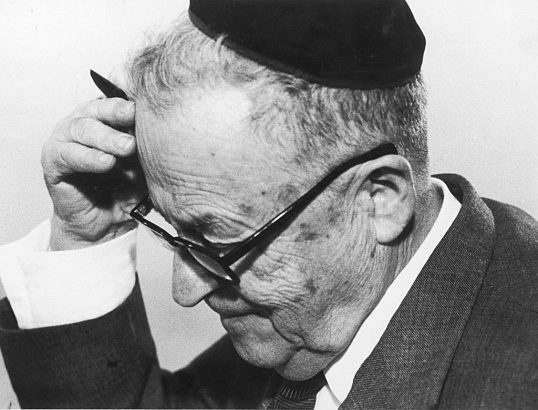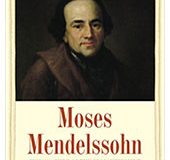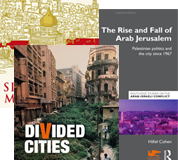As the spiritual bedrock of Judaism, Jerusalem had been a magnet for millennial longing. For centuries Jews intensely preserved their spiritual attachment to their Jerusalem. At different times, Jewish individuals and groups from the Diaspora yielded to this longing, gravitated towards Jerusalem and settled there, with the explicit commitment of spending the remainder of their earthly life in close proximity to the Western Wall. Jewish they were, pious and traditional in their ways and customs, and when they arrived in Jerusalem they tended to huddle together in discrete ethnic communities that, their shared religion notwithstanding, had little to do with each other.
The Canadian-coined term ‘Two Solitudes’, popularised by Hugh MacLennan in his 1945 novel, describes a certain perception of Canadian experience, in which the country’s two main founding ethnicities, English-speaking and French-speaking communities, dwell in proximity to one another yet maintain a relationship essentially characterised by exchanged expediency, scarce and reluctant communication, lacking any genuine mutual interest. Whatever necessary political and economic traffic takes place between the two communities, it is done with a tacitly acknowledged presumption of reciprocal indifference.
Similarly, Jewish communities in Jerusalem in the late 19th and early 20th centuries – the two main ones being the Ashkenazi and Sephardic congregations – preserved their group insularities; each was not only inward looking and autonomous, but also maintained strong ties with their Diaspora ‘homelands’. Thus Ashkenazi Jews in Jerusalem looked to Eastern-European Jews, while the city’s Sephardic Jews maintained close bonds with Sephardic communities in Turkey, Crete, Rhodes, and the Balkans.
A classical definition of Diaspora posits a vigorous web of individuals and communities that, though dwelling in geographically distant localities, constantly interact, not only through economic exchange but, more importantly, through the unbroken circulation of people, information and cultural content, producing a sense of kinship. Though there is no question that solidarity among Jews was a primary and binding principle, in Jerusalem the two communities were far more attached to their respective ethnic identities than to each other. Tensions occasionally flared and boundaries were zealously buttressed; in short, the normal mode of existence among the Jewish communities in the Diaspora was replicated on a much smaller scale in Jerusalem.
In Jerusalem of the pre-Zionist era, then, exile was, so to speak, doubled. Coming home from a place of ancient exile (the Diaspora), the exiles settled down in a pattern that reproduced … the exilic. Thus, the Ashkenazi Jewish community that resided in Jerusalem explained itself as an expatriate community related to an imaginary Diaspora homeland of ‘Ashkenaz’ (generically understood to mean Europe/Eastern Europe). The Jerusalem Sephardic community in Ottoman Palestine similarly defined itself by its strong ties to other Sephardic communities in Europe and the Ottoman Empire.
Two Storytellers
S. Y. Agnon’s Agunot and Yehuda Burla’s Two Sisters, contemporaneous and well-established in Hebrew literature, exhibit some striking similarities: their subject matter (the treatment of Jewish life in Jerusalem at the turn of the century), the fabulist tone in which they were written, and the way they evoked the ‘two solitudes’. Each takes place within the confines of a tightly-knit, exceedingly pious Jewish community in Jerusalem, living cheek by jowl with the ‘other’ Jewish community. Both stories are pervaded by a sense of gloom and fraying gentility that melds the personal to the historical. And, once the sway of the stories themselves waned a little, I realised with some astonishment that though they share a place and a time, religious devotion and deep love for the Torah, there was little or no mention of the ‘other’ Jews in their vicinity. Agnon’s story unfolds in an Eastern-European, Yiddish speaking community; Burla’s, though briefly acknowledging the presence of other Jewish ethnicities, moves on quickly to focus exclusively on the Sephardic, Ladino-speaking community.
From a literary point of view, the two stories also share a certain quality and form that Walter Benjamin would recognise as belonging to the traditional genre, the decline of which he laments in his seminal 1936 essay The Storyteller. Storytelling as a genre, he thought, was disappearing from the European literary landscape. Benjamin characterises storytelling as a short fiction that ‘contains, openly or covertly, something useful. The usefulness may, in one case, consist in a moral; in another, in some practical advice; in a third, in a proverb or maxim.’ An additional feature of the story is its ‘chaste compactness [that] claim[s] … a place in the memory of the listener.’ Thus, the storyteller Benjamin describes is both a custodian and purveyor of personal and collective memory: that is, tradition.
He attributes the decline of storytelling to the rapid social transformation that occurs when demographic changes accompany the advent of modernity: ‘a generation that had gone to school on a horse-drawn streetcar now stood under the open sky in a countryside in which nothing remained unchanged but the clouds, and beneath these clouds, in a field of force of destructive torrents and explosions, was the tiny, fragile human body.’ The storyteller belongs to the people, speaks to his tribe, and draws his inspiration from them. His task is to observe and retell. He is the literary equivalent of the chronicler of history.
Benjamin’s storyteller invokes an image of a companionable narrator who sits with a group of friends and kinsmen, telling them a tale in which he may act as an observer, an actor, or a privileged insider, but never an outsider. If there are ironies in his tales, he is guilelessly oblivious of them. He assumes like-minded commonalities with his audience, a shared world of beliefs, superstitions, quaint linguistic singularities, tribal peculiarities and affinities.
Agnon’s Agunot, and Yehuda Burla’s Two Sisters are examples of Benjamin’s genre of storytelling. Each offers a compact plot, in which each event follows a previous one, and precedes another, with little concern for detail or psychology. Each narrator is aware of the precariousness of the cherished tradition, and tries to stem, or at least slow down, the surge of modernity by traditional tropes: the pathos of Jerusalem, the healing beauty of the Torah, naive beliefs, the cosiness of the familiar tribe. Do they succeed? Do the stories they tell really remain hermetically impenetrable to the ‘Other’, the ‘Other’ being different Jews, different people, different mores, modernity? My view is that both ultimately fail to keep intact the hitherto comfortable dialectic between the other-worldly reality of the Diaspora and dwelling in Jerusalem. Agnon’s narrator ends his tale in an unresolved, ghostly impasse. Burla’s resolves the potential impasse by a this-worldly closure and a hint about the possibility of new order.
It is clear, seen from our own point in time, that these stories reflect that period’s angst. The Jerusalem we encounter in these stories stands on the cusp of modernity, while its inhabitants are in thrall to a bygone era. A question haunts the two communities: faced with the decline of their accustomed and established ways of life, what kind of hope or vision is there?
In these two very different stories, the emphasis is on movement between the Diaspora, which Agnon renames ‘the world of confusion’, and Jerusalem, which Burla calls ‘Shelter in the shade of Zion’. In Agnon we sense restless hesitation between Diaspora and Jerusalem. In Burla the denouement is one directional, harmonious and final. What has been a quarrelsome reality in the Diaspora is harmonised in Jerusalem.
For the Love of Jerusalem
S. Y. Agnon (1888-1970) and Yehuda Burla (1886-1969) lived more or less concurrently and in the same place. Though both wrote in Hebrew, Agnon wrote from a Yiddish-based culture while Burla’s oeuvre was inspired by Sephardic culture’s lingua franca, Ladino. Jerusalem is an epic presence that permeates the work of both, saturating their unique ‘writerly’ sensibilities, something Agnon disclosed in his speech at the Nobel Banquet at the City Hall in Stockholm, 10 December 1966:
‘I was born in one of the cities of the Exile. But always I regarded myself as one who was born in Jerusalem. In a dream, in a vision of the night, I saw myself standing with my brother-Levites in the Holy Temple, singing with them the songs of David, King of Israel, melodies such as no ear has heard since the day our city was destroyed and its people went into exile. I suspect that the angels in charge of the Shrine of Music, fearful lest I sing in wakefulness what I had sung in dream, made me forget by day what I had sung at night; for if my brethren, the sons of my people, were to hear, they would be unable to bear their grief over the happiness they have lost. To console me for having prevented me from singing with my mouth, they enable me to compose songs in writing.’
In his encomium to Yehuda Burla, Ben-Zion Yehoshua writes lovingly that ‘Burla’s opus, in novel and story, is a resplendent resource for encountering the old Sephardic way of living in Eretz-Israel in general and in Jerusalem in particular. His writing consists in circles within circles that weave in and out of each other – the Jerusalem courtyards, the folkloric culture, the congregation, and then, expansive transcendence of what it meant to be a Jerusalemite … In his works, Burla pulls us through a time tunnel to Ottoman Jerusalem and immortalises in letters an ethos that vanished completely from our present condition.’
The deep, almost unfathomably constitutive love for Jerusalem that fuelled the creative force in these two early Hebrew authors permeates their writing, so much so that Jerusalem is as palpable a presence in their stories as though the city were a living breathing character.
Agnon’s Agunot
In Agnon’s short story Agunot, we encounter a folkloristic storyteller who speaks to an audience that he assumes shares his world view, from its superstitions to the smallest verbal conventions. In the mode of Walter Benjamin’s storyteller, the narrator in Agunot is an insider to the community and tells a gloomy tale of love and desolation. This story, an early fruit from Agnon’s pen, already prefigures its author’s singular sense of tragic irony, unrequited love and irremediable error.
‘Aguna’ is a term in Jewish matrimonial law which describes the status of a wife whose husband is absent but not confirmed dead. The classic case of this is a man who has left on a journey and has not returned, or has gone into battle and is missing. It also refers to a woman whose husband refuses to grant her a divorce. The term is also used to describe metaphorically the condition of all mismatched souls irrespective of gender. Agnon’s story plays ironically upon the two meanings of the term: it is about a man and woman who marry each other while each is secretly attached in love to another. The marriage ends in divorce without ever being consummated, but none gets to marry the one he/she longed for.
The story begins with an invocation of Jerusalem: ‘It is said: a thread of grace is spun and drawn out of the deeds of Israel, and the Holy One, Blessed be He Himself, in His glory, sits and weaves – strand on strand – a prayer shawl, all grace and all mercy, for the congregation of Israel to deck herself in. Radiant in the light of her beauty she glows, even in these, the lands of her Exile, as she did in her youth in her Father’s house, in the temple of her sovereign and the city of sovereignty, Jerusalem.’
A rich Jewish grandee in Jerusalem has one and only child – Dina, a daughter whom he keeps in luxury but cloistered in a golden cage. When she comes of age, he sends emissaries to the Diaspora (Poland) to find an eligible match for her. Ezekiel is found, a well-pedigreed, outstanding Yeshiva student. So brilliant is this young man that his future father-in-law decides to build for him a Yeshiva in Jerusalem with a synagogue attached. He commissions a young artistic carpenter, Ben Uri, to build the ark for the synagogue. Ben Uri is lodged in studio in the garden where Dina walks. As he works, he sings and his beautiful voice draws Dina, the young bride to be. She visits his studio and looks at him working. As might well be expected, they fall in love. Dina, jealous of his love for the wonderful work of art he is crafting, is moved by an evil urge to damage the Ark by pushing it, undetected, from the balcony on which it was standing. The community is outraged at Ben Uri, he is banished in disgrace and the ark is warehoused, discarded and scorned. The wedding proceeds as planned but it turns out that the bridegroom is haunted by his love to the young servant girl he grew up with in Poland. Unfulfilled, joyless and doomed, the marriage is dissolved. Ezekiel goes back to Poland, where Freidele, his young love, has already been married and gone. Ben Uri is never seen again. The synagogue, built for Ezekiel in expectation of his greatness, falls into disrepair. The rabbi who officiated over Dina’s and Ezekiel’s marriage and divorce ceremonies is doomed to shoulder the burden of this colossal failure, and ends up a phantom wanderer between Diaspora and the Holy Land.
The Jerusalem community we encounter in Agunot considers itself a branch of the Diaspora. Its members try to maintain their tightly knit traditions by importing love and knowledge from the Diaspora, resisting the possibility that these could be found in abundance in the city they dwell in and cherish. For all the rapture and purity that Jerusalem bestows upon her dwellers, they could not sever the Gordian knot to their Diaspora past, to the ‘House of confusion’. The punishment is severe.
Burla’s Two Sisters
Burla’s story also opens with an invocation of Jerusalem. However, whereas Agnon appeals to a Jerusalem of spiritual awe, Burla describes a city of tranquil joy:
‘In every one of the many courtyards of Jerusalem you might have run into them, old men and women in the twilight of their lives, immigrants from all countries of the world, living alone or in company, in cave-like rooms, in dim alcoves, like monks in some great monastery. But the look on their faces was different from that of the quiet ascetics. On the contrary, they were full of quiet – and joy. On the faces of many of them the light of purity would rest; security and the pleasure of a great certainty shone forth from their actions, the pleasures of a peace that comes after one does away with all the accounts and labors, all the worries of the great way, the way of man’s life.’
Malka and Busa Rivka, the two sisters of the title, have spent the better part of their life in Rhodes. They arrive in Jerusalem separately, in the November of their lives, and live as though they were strangers to each other. It is in Rhodes that the story of their terrible quarrel and irreconcilable rupture takes place. Busa Rivka was rich and barren. Malka poor but blessed with children. When Busa Rivka observes her husband doting on her nephews, she is filled with envy and rage, and forbids him to do so. When finally she has a child, her sister, urged by ‘the evil one’, spreads ugly gossip about her. The two sisters pay dearly for their malice and jealousy. They both lose everything. Then each collects whatever she has left and moves to Jerusalem. There they live in genteel poverty, each working to save some money to make a donation to the synagogue. Each elderly woman, unbeknownst and within a few days of each other, approaches the local rabbi ‘Haham Meshulam’ to contribute a scroll of the Torah and a cover. In return they ask that it be said that their contributions were made to atone for their sins on earth. On the day of the festival that took place at the synagogue, ‘next to the platform sat the two old women, dressed in striped dresses, according to the fashion of Rhodes, and because of the light of the two brothers – the two scrolls – there was light of sanctity on their faces and limitless joy in their souls.’ Near the story’s end, the storyteller (who is a character in the story) concludes her tale thus: ‘How happy we are that God has seen fit to let us see them alive here –with Jerusalem sheltering them with her peace.’
In Burla’s story, Jerusalem is a city where people come to as to a journey’s end. It is a place of peace and emotional repair. Whatever strife and anguish tore families apart in the Diaspora, in Jerusalem it is being put right. Jerusalem is the centre in which the demons and torments of exile are foiled. Whereas Agunotends in bewildered rootlessness and even despondency, Two Sisters ends in a contented smile.
Agunot was written in 1908. Burla’s story is a later creation, published for the first time in 1964, but it is my opinion that it was written sometimes during the 1920s. Both stories hark back to an earlier time, when Jerusalem was still a maze of cobbled alleyways populated by traditional, God-fearing Jews, leading extremely secluded lives. Zionism is never even hinted at in either of the stories. There is no reference even to the new neighbourhoods that had already been built outside the walls.
Christopher Hitchens once observed that today’s Israel resembles the Jerusalem of Agunot. ‘Israeli Jews,’ he wrote in his memoir Hitch 22, ‘are a part of the diaspora, not a group that has escaped from it.’ I think he was wrong. Even early in the 20th century, the system of Jewish Diaspora was already being critiqued, if not declaratively challenged yet, by the early Hebrew authors. Even as these two perfectly contemporary writers are attempting to channel a world of Jewish piety, they are already framing it in terms of the modern forces that are pounding against the walls of Jerusalem. They tell of intense faith, the consolations of tradition, two hermetic solitudes that can only be preserved as long as they are maintained in strict adherence to Diasporic ethos. And yet, the subversive undertow that is the 20th century’s promise and presentiment is already being felt and is incorporated into the very fabric of the tales. Between Agunot’sphantom vacillation and the subdued finale of Two Sisters, we as readers feel we are bidding farewell to an entire way of life and existence that is no longer sufficient or valid. The movement is towards a different kind of relationship between Jerusalem and Diaspora, in which Jerusalem stands for liberation and self-reliance. There is an elegiac tone in these two stories. Their essence is captured by Hannah Arendt’s words in her famous 1964 interview with Gunter Gaus: ‘The specifically Jewish humanity signified by [Jewish] worldlessness was something very beautiful … it was something very beautiful … Of course a great deal was lost with the passing of all that.’





































